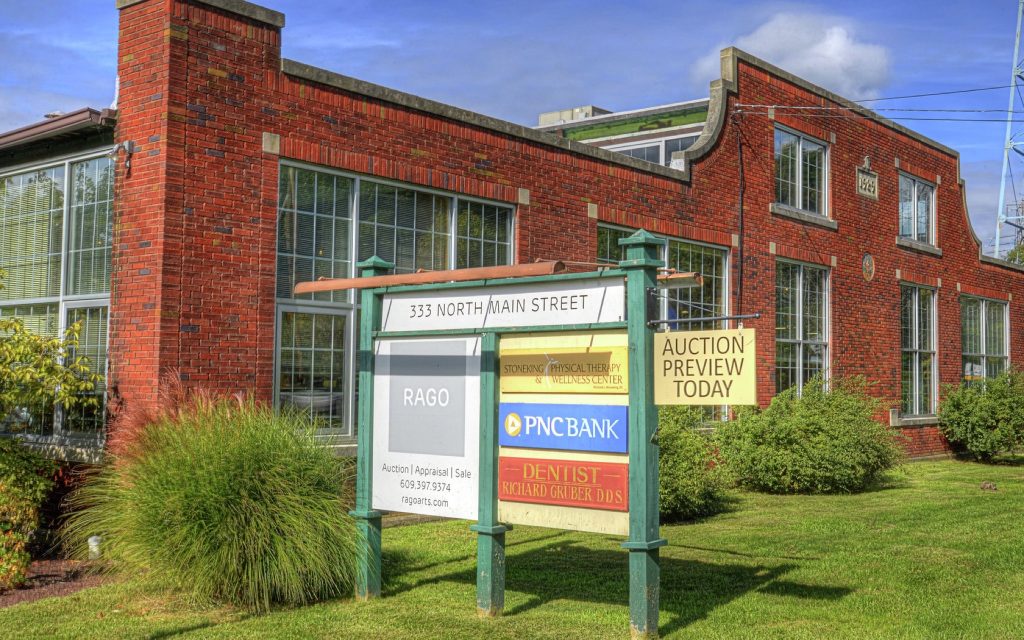Before the pandemic (BP), if I had a little time on my hands, I liked to hang out at Rago Arts & Auction Center, in Lambertville, NJ, on its evaluation days. On most Mondays, for a few hours in the afternoon, many of Rago’s super-astute specialists would make themselves available to the public, free of charge. Being there in person was like watching raw footage of an “Antiques Roadshow” episode, with all the quirky, eccentric parts still in there.

Rago started the event in 2002, piggybacking off the success of “Roadshow,” which itself began five years earlier and regularly features Rago’s husband-and-wife owners, David Rago and Suzanne Perrault. As the PBS series rose to prominence, everyone—even you; admit it—started digging through their attics, their basements, their neighbors’ yard sales, and sprawling flea markets.
For those who had no idea what they were looking for (the great majority) and even those who did, “Roadshow” and, locally, Rago’s evaluation days were where fortunes were made. Or, at least, authenticated. Though, way, way more often, those hopes were dashed.
On a cold Monday afternoon, BP, I got there early and watched as the rows of folding chairs comprising the waiting area at the front of the Lambertville auction house gradually filled up and then overflowed with collectors. One of the specialists tells me that a lock of George Washington’s hair turned up recently, as did Marilyn Monroe’s scarf (confirmed) and compact (unconfirmed).
On this afternoon, paintings (prints, more accurately) and porcelain (figurines and large plates) will be in the greatest quantity, but the wide (and weird) assortment of other stuff makes any neat classification impossible. It’ll come stuffed in boxes and large bags and wrapped in plastic, sheets, towels, garbage bags, bubble wrap, and Mexican-style blankets. Much of it protected in the hope that it’s worth preserving.
As they register—everyone’s seen on a first-come, first-served basis—they’re asked to divide their stuff into one of three categories, art, jewelry, and miscellaneous, to ensure they’re seen by the appropriate specialist. The limit is six items per person, though most appear to have brought much less than that, effectively putting all their hope on a couple precious-looking things.
One of the guests hands over a large blue and yellow decorative plate to a specialist, who, not long ago, often found himself on the other side of the table, with parts of his own collections. “This wants to be 18th-century,” the specialist says. “Looks right here. And it looks right here,” he says, slowly turning the plate inches from his face.
“Whatta you think it’s worth?” the collector asks. The question will be asked again and again, all afternoon long. Whether they’ll admit it or not, it is the reason everyone’s here, after all. On this particular afternoon, I eavesdropped on more than a dozen evaluations—technically, these aren’t appraisals, which are a much more elaborate, formal process—and the question came up in every single one. Some pretended like it’s inconsequential, but they still wanted to know.
“$350 to $400,” the specialist says. To my woefully untrained eye, it’s more than I expected. But it’s less than what the collector wanted to hear, by the look of his reaction. “I took a shot,” he says, and drifts away.
“That’s a hard thing to do 420 times a day, to disappoint somebody every time you open your mouth,” the specialist said to me when we were talking before the collectors started showing up.
The disappointment’s only temporary, though. It seemed pretty safe to assume every one of these collectors would be back to rummaging as soon as they had the chance, each of them driven by the thrilling possibility that they could uncover the find of their lives.
A parting note: Rago has resumed its evaluation days, but, in light of the pandemic, it’s asking that you schedule an appointment, rather than just show up. You can do that here. Also, bring any documentation that ties into the things you want appraised—receipts or letters, that sort of thing. Every little bit informs the review.



